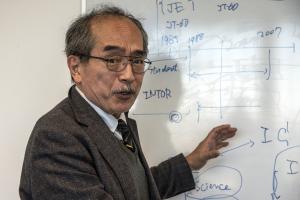Yutaka Kamada, Science & Technology
In his late childhood and early teens, Yutaka Kamada developed two passions: one for growing cactus, the other for fusion energy. Half a century later, his cactus collection comprises 500 plants and Yutaka has been appointed Deputy Director General (Science and Technology) of the largest fusion research program ever implemented. What do growing cactus and managing a fusion project have in common? Probably the need for patience, for a deep understanding of processes at work, and for rigorous procedures to ensure success.
Fusion entered Yutaka's life through a book, read at age 14. "It was called Challenge to Plasma Fusion, by a famous plasma scientist named Shoichi Yoshikawa. My father, a chemist, had advised me to read it and I was instantly fascinated," he explains. "Recently, an old friend from that time congratulated me on my appointment as ITER Deputy Director-General and reminded me how, 50 years ago, I was absolutely determined to 'challenge fusion!'"
Studying nuclear engineering, which included nuclear and plasma physics, was the obvious way to realize this teenage ambition. Yutaka obtained his PhD from Tokyo University in 1988 and joined the research staff of the JT-60 experiment that same year, rose to senior scientist in 1996, and was eventually appointed Japanese leader of the Europe-Japan JT-60SA fusion project (2008-2020) and Deputy Director General of the Naka Fusion Institute (2018).
Yutaka's direct involvement with ITER began in 1999 when he joined the International Tokamak Physics Activity (ITPA), whose Coordinating Committee he chaired between 2010 and 2013. His participation in the ITER Council Science and Technology Advisory Committee (STAC), which he chaired in 2016 and 2017, brought him even closer to the inner workings and decision-making process of the project, as did his role as Japan's representative to the ITER Council from 2019 to 2022.
Experience accumulated at the helm of JT-60SA (where ITER Director-General Pietro Barabaschi led the European contribution from 2007 to 2021), as well as at the Naka Fusion Institute and in the key structures of ITER will prove precious in Yutaka's new position. "The most important, at this point in time, is to set a clear target and timeline, and for this integration is key," he says. "I mean, not only technical integration, but also human. We need to better integrate people, staff, and teams from the worldwide ITER project. If we all share the same objective, if we improve the sharing of information both within the ITER Organization and between the ITER Organization and the Domestic Agencies, then I'm optimistic about the future."
Because each of the seven ITER Domestic Agencies reflects its own national culture, preoccupations and approaches, the interaction between them and with the ITER Organization can be challenging at times. Like the present Director-General, Yutaka thinks that a better integration, better communication and an even closer partnership are essential to ITER success. "The Domestic Agencies are responsible for procuring ITER components and systems. But their contribution should not stop there: Domestic Agencies should be involved in both the assembly and operation phases because these phases are the result of their manufacturing. And because they love their components and want to see them perform."
The expanded role that the new management wishes to assign to the Domestic Agencies is part of the larger overhaul that an impending reorganization, along with the definition of a new baseline, will make possible.
The teenager who, 50 years ago, wanted to "challenge fusion" is still very much alive in Yutaka. However, what he did not expect then was that the challenge would be as much about organization and integration as it is about physics and engineering.
See the press release issued after his selection in English and French.


